© 2025 ALLCITY Network Inc.
All rights reserved.

A 4-5-1 start for the Colorado Avalanche certainly isn’t what anyone was expecting coming into this season. Even the people who seem to live to tell the world how overrated the Avs always are couldn’t have imagined the first 10 games would have looked anything like they did.
Between the random COVID-related absences, the short roster forced by the salary cap, and another Pavel Francouz injury that has made Jonas Johansson the de facto backup goaltender once again, it’s been 10 games full of constant lineup changes and wildly inconsistent hockey.
Because of preseason expectations, the 4-5-1 record almost feels apocalyptic given the feeling around the team right now. In reality, it’s not. With several days between games yet again, I wanted to dig into a few things to see what has and hasn’t been working for the Avalanche to this point.
It hasn’t been all bad so let’s start with what has actually worked so far.
The Good
This section is going to be marked entirely by Colorado’s 5v5 play, which more or less matches the vaunted eye test. They’ve been competitive at 5v5 this season and it shows.
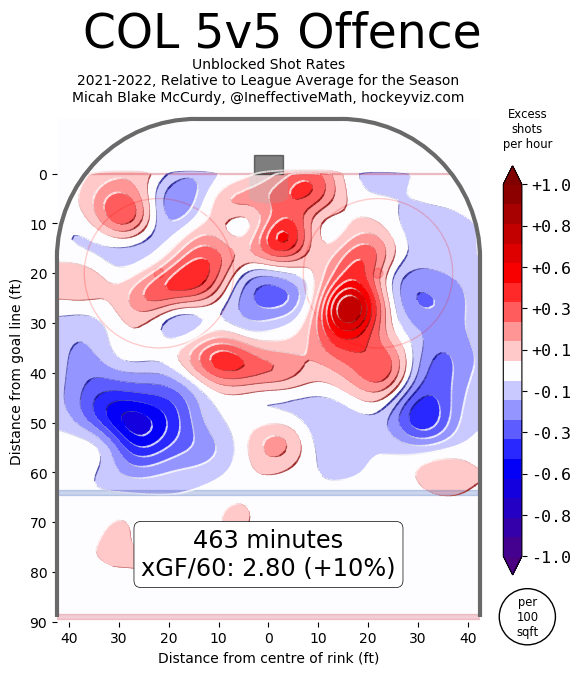
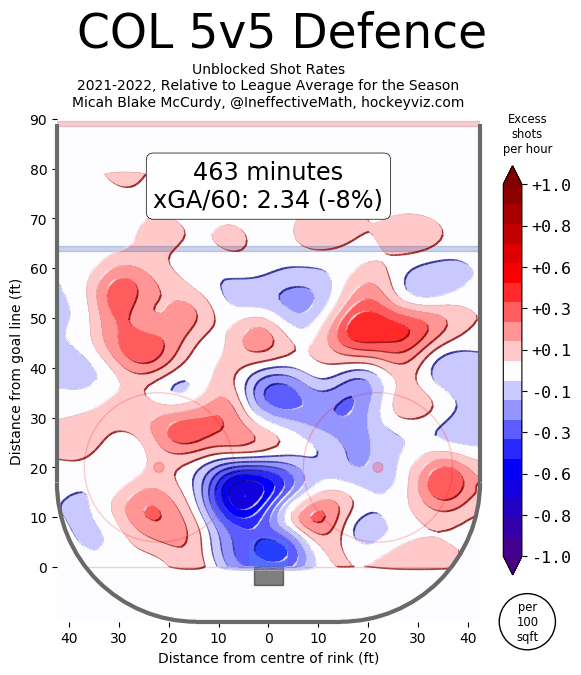
Since there are always questions about how to read these, I’ll reiterate that on offense, red is good and blue is bad and on defense the opposite is true. On offense, you want positive numbers and on defense you want negative numbers.
With that in mind, this shows Colorado’s 5v5 play is very good at creating shots in quantity and from dangerous areas while the defense does a solid job of keeping the highest-quality chances limited.
In regular list form, here’s where Colorado’s 5v5 play ranks in various categories:
- Corsi For %: 50.51 (16th)
- Shots For %: 49.50 (16th)
- Goals For %: 42.86 (27th)
- Expected Goals For %: 53.89 (7th)
- Scoring Chances For %: 55.22 (4th)
- High-Danger Chances For %: 56.96 (2nd)
Colorado’s ability to generate quantity and suppress it is struggling, clearly, but their ability to both generate and limit quantity is among the league’s best. In rate form, Colorado is fifth-best in the NHL in generating scoring chances and fourth-best at limiting them per 60 minutes.
While Colorado has had a revolving door of defensemen with each of Sam Girard, Cale Makar, and Devon Toews missing time up to this point, the unit has generally been pretty good overall considering the level of talent that has been in and out of the lineup.
One of the reasons the defense has been stabilized is the play of rookie Bowen Byram, who at 20-years-old leads Colorado’s defense in scoring with eight points (3g, 5a) in 10 games while, as we’ll see below, playing very good defense along the way.
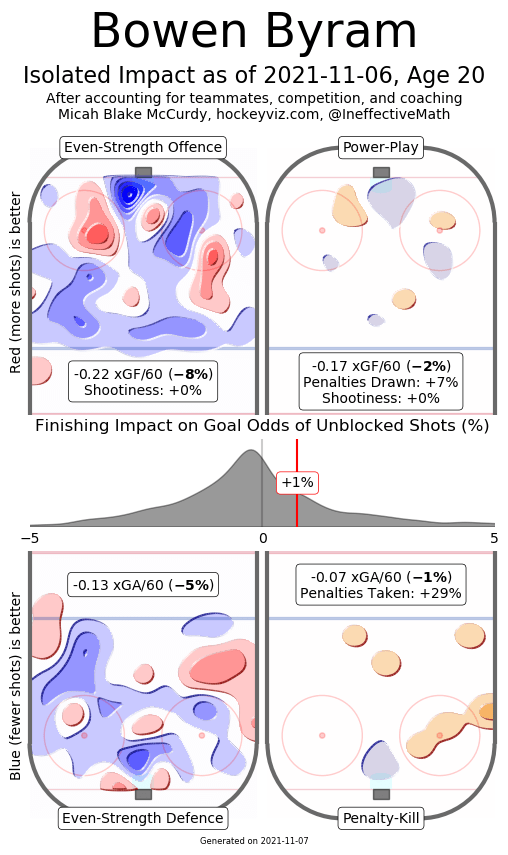
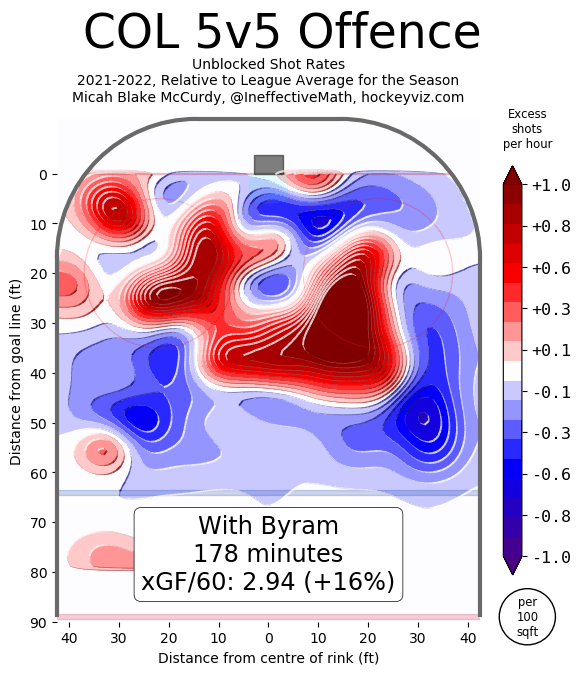
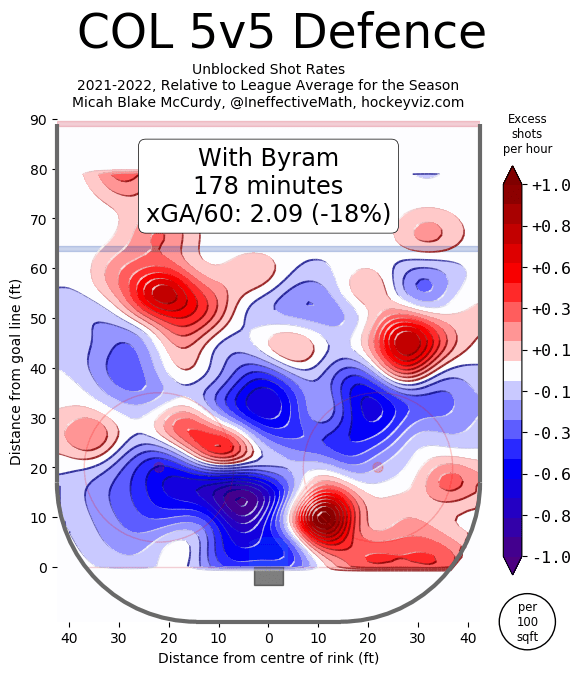
A couple of things really stick out here. First, Byram’s isolated impact (the first picture posted) shows a player who is crushing it defensively while not personally driving play on the ice.
That isn’t to say he isn’t taking advantage of opportunities because obviously you don’t post eight points in 10 games without cashing some chances. The isolated impact at -8% offensively is at odds with how the Avalanche generates offense with Byram on the ice in general, which is at a sterling +16%.
Part of that is deployment as the coaching staff has put Byram primarily next to Erik Johnson or Cale Makar (his two most common partners by a wide margin) and Byram regularly sees ice time with Nathan MacKinnon, which helps explain some of the play-driving effects we see in the charts above.
Where there is no dispute, however, is in Byram’s defensive impact. It’s excellent in both isolated impact and when he’s on the ice generally. Byram has been opportunistic on offense, cashing in on the play being driven by those around him but he has propped up both Makar and Johnson defensively as their numbers away from him are actually worse than with him.
Given Byram had 19 NHL games to his name coming into this season, that’s a pretty impressive start to the season next to two highly-touted teammates.
No matter how you slice it, Byram has been one of the core strengths of the Avalanche so far.
There have been more good performances on the Avalanche roster. Logan O’Connor has been a consistent performer and Nazem Kadri has returned to the form displayed most of his career where he produces points, plays with an edge and gives some of it back defensively along the way.
This isn’t to say there aren’t more good things on the Avs roster, but that more of the high-impact guys have more complicated profiles so far.
There has been one area of the team that has been downright bad, however, so let’s tackle that first.
The Bad
You all saw this coming. Special teams in Colorado this year have certainly not been, uh, particularly special. I think the word we’re looking for here is awful.
We’ll start on the power play, everyone’s favorite thing to whine about no matter how good the unit actually is. Last year, for example, the power play was tops among people’s list of complaints despite it being an elite unit in terms of creating high-quality chances. It wasn’t elite at finishing but merely very good and the PP was ranked 7th in success rate.
This year, however, ahhhh none of that is true.
The 10.5% success rate of the PP is 30th in the NHL, ahead of only Seattle and Vegas and .2% behind the putrid Arizona Coyotes.
While the finishing has once again been lagging behind, the process just isn’t much better so far this season. Before getting into the numbers, it would be intellectually dishonest to pretend this unit has been operating at 100% strength all season. It hasn’t been and still isn’t. The team’s preferred top unit has barely played together so there’s some context to this awfulness, but in general everyone in the organization would tell you that despite the absences, this just hasn’t been good enough. To the numbers.
- Shots per 60: 47.39 (23rd)
- Expected Goals per 60: 6.28 (19th)
- Scoring Chances per 60: 50.18 (15th)
- High-Danger Chances per 60: 18.59 (17th)
- Shooting percentage: 7.84 (29th)
I only included the last one because it was the only encouraging number in the bunch. How is it encouraging when they sit 29th in shooting percentage on a power play? Well at 7.84 they would be in range of Anaheim last year, which was the worst PP the NHL has seen since the league began recording the success rate of the man advantage.
Last year’s Avalanche team had a shooting percentage of 13.70, which was middle of the road (they underperformed, remember) but nearly double what they’re currently producing.
This is a long-winded way of saying: Power play bad. In chart form, it’s somehow worse.
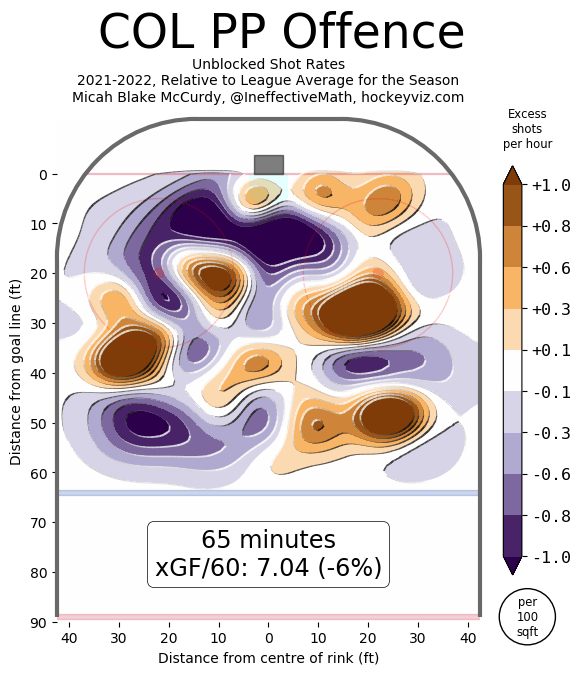
On the other side of the ice is a penalty kill that has an 84.6% success rate, good for 12th in the league. That, however, largely due to the seventh-best save percentage from their goaltenders at 91.49% on the PK.
One of hockey’s great adages is that your goaltender has to be your best penalty killer. It’s true, but he can’t be your only penalty killer and right now that’s where the Avs are.
First, in chart form.
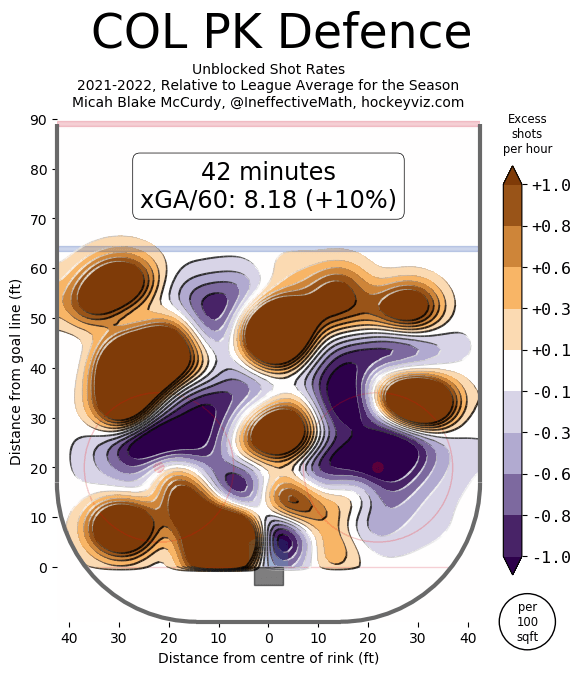
Remember, positive numbers are bad defensively. At +10%, this is really bad.
In list form:
- Corsi Against per 60: 119.54 (31st)
- Shots Against per 60: 64.58 (30th)
- Expected Goals Against per 60: 7.35 (23rd)
- Scoring Chances Against per 60: 49.47 (13th)
- High-Danger Chances Against per 60: 21.98 (25th)
Not great, Bob!
The only number in there that isn’t downright ghastly is the scoring chances against and that’s basically negated because the high-danger chances are so high. This unit doesn’t have the excuse of lacking personnel beyond Toews and everyone, and I mean everyone, who is a regular is struggling (yes, even LOC).
The other aspect of the Avalanche I’m putting in the “bad” category right now is goaltending. Darcy Kuemper, in particular, has been on the upswing with several solid outings in a row but he’s still giving up a leaky goal here or there and the Avs are just not good enough right now to overcome those kinds of problems.
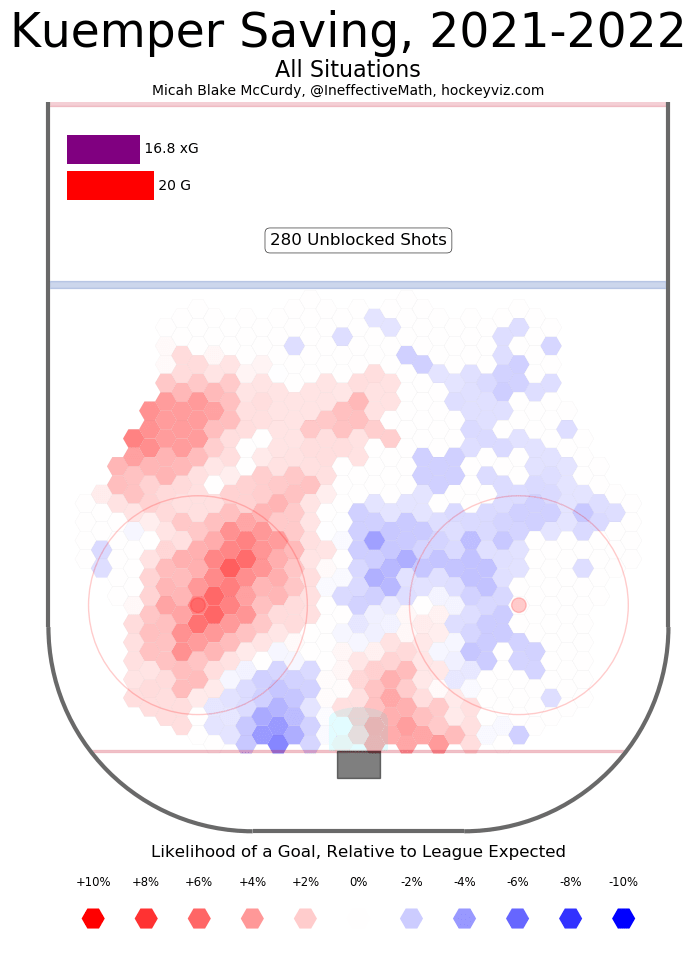
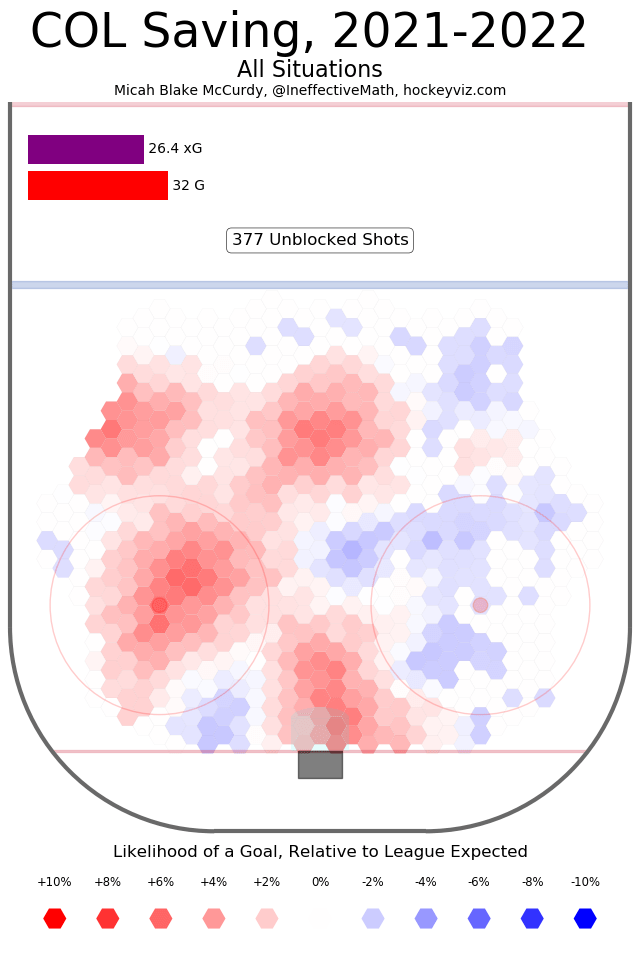
Kuemper’s isolated goals given up versus expected is the first chart and the bottom is Kuemper and Johansson combined.
Neither is good. It’s not atrocious, but it’s just not good enough, especially given the struggles of the team in front of them.
As mentioned, Kuemper appears to be finding his game a bit as his season so far can be broken into two equal parts. His first four starts he was 2-2 with a .894 save percentage and his last four he is 2-2 with a .923 save percentage.
If the Avs pick up their play in front of him, if Kuemper can trend more towards the last four games on a consistent basis, it will justify the hefty price to acquire him.
Johansson hasn’t been good enough for the Avs (not that everything is on him in his two starts, of course) but if you remember he should be Colorado’s third goaltender and that Pavel Francouz is hopefully working towards a return sometime in the next few weeks, well, we’ll just see how that plays out.
The real stress on the team, however, has been a few underperforming star players and that’s where this gets more complicated for the Avalanche.
The Ugly, But This Should Get Better
I use the word complicated because for every good, there’s a bad, which means that for every bad, there’s a good. Newton’s Laws of Motion would love this section, I guess.
I want to start here with Nathan MacKinnon. The guy has 10 points in eight games, so it’s not exactly like he’s been out there playing like a scrub, okay? We’re going to acknowledge that right now. When you look at his fancy stuff, you still see an elite player. I’ll prove it, naturally.

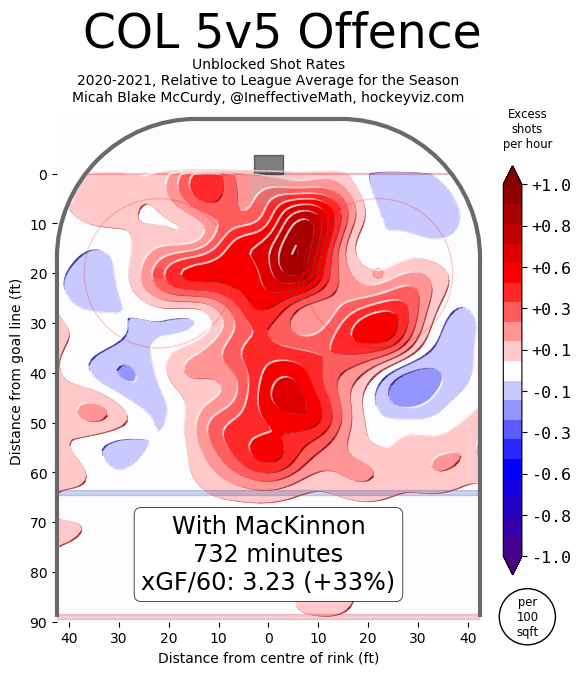
Holy smokes is Nathan MacKinnon good. Let’s talk about that first chart, which compares him to last year.
The play-driving isn’t as good but -2% isn’t a significant drop or anything. The defense is better, which is nice, but the finishing has taken a big step back.
Given MacKinnon has just one goal so far, that all tracks. I don’t have a lot more to say about that top chart, which just drives home that even when the Avs are needing more from MacKinnon, they’re still getting a decent amount.
Now, if you’re an eagle eye and noticed that MacKinnon chart with +33% is actually dated last year, then congratulations, you have foiled my clever ruse. If you didn’t notice, well, that is last year’s isolated impact from MacKinnon. +33% is basically one of the highest numbers you will ever see on a chart like that and for him to have driven play at that level across an entire season is absurd. Guy is good.
Let’s actually see this year’s, though.

Ahhhh…that’s a big difference.
Keep in mind these percentages are relative to league average, so with Nathan MacKinnon on the ice, the Avalanche is one percent more dangerous than with the average NHL forward.
He’s only played in eight games, so this is why this section includes the assumption it’s going to get better. If it doesn’t, the Avs are in trouble basically regardless of anything else that happens.
If (when?) it does improve, the Avalanche offense will get right back to humming right along. This is a major outlier for MacKinnon in the last four years, so it feels like a fair assumption that things will turn around for him.
The other guy on the team things should turn around for is Cale Makar, who has battled injuries and inconsistency all season.
His play at even strength has been solid but uneven. Where he’s really separated so far is his play on the power play. This was his isolated work on the PP last year. Prepare yourself. This is nuts.
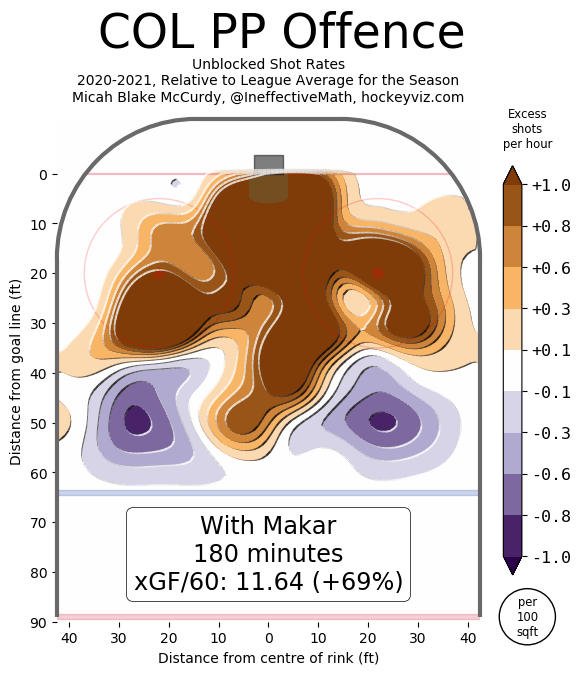
And now this year.
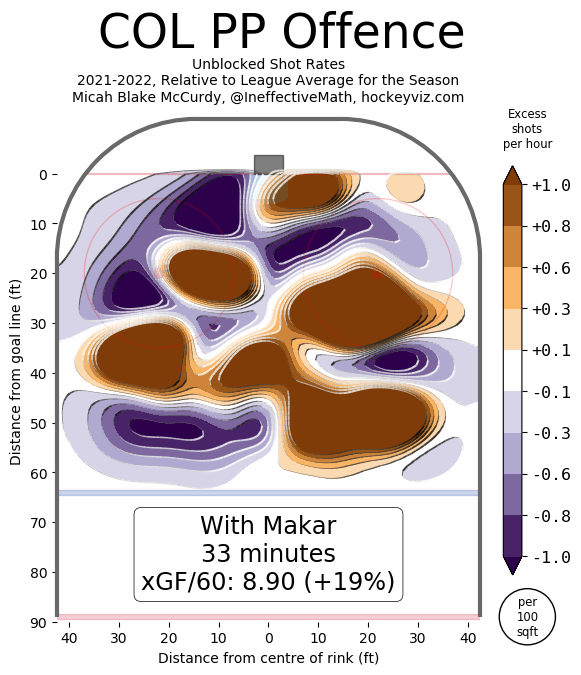
That’s a huge step-down. Want to see an even bigger drop-off? Here’s this year’s Avalanche PP without Makar running the show.
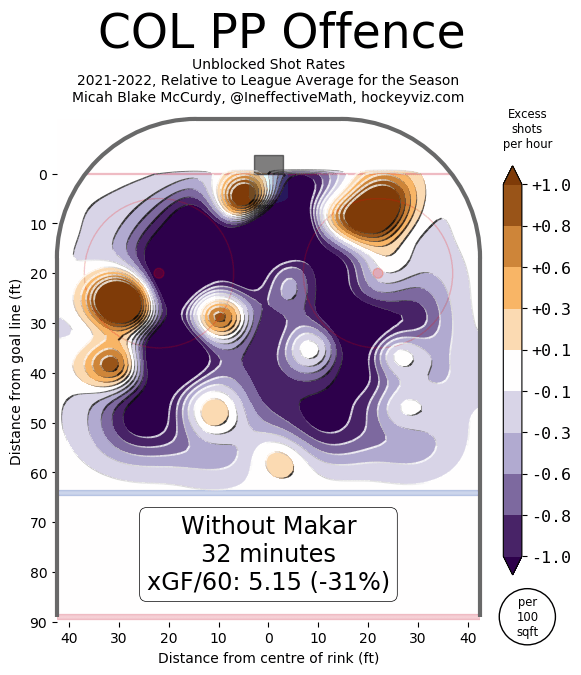
So, fair to say he is vital to the success of that unit operating at 100%. Everyone gets excited about the new guy in town or wants to push a Sam Girard joint-effort on the power play but this is an area where the coaches have it dead right.
Four forwards (three of them from the top line) and Cale Makar. That’s the top unit. It doesn’t need excessive tinkering, it needs its main characters to both play in the games and when they are actually healthy, play better.
That’s it. That’s the part of Makar’s game that needs to get better. His play at even strength can absolutely get better when doing this deep dive, that was what really stood out to me as a gigantic problem.
With six points (two on the power play!) in eight games, it isn’t like Makar has been an abject disaster. That’s the point, though. Outside of the special teams units as a whole, and kind of goaltending, there hasn’t been much in the way of high-impact players being outright good or bad.
It’s been a healthy mixture of both, which is encouraging because it means they don’t have to correct everything, just some things.
What does it all mean?
Existentially, nothing.
In regards to this Avalanche season, it means there’s a whole lot of room for improvement from a team we know has a lot better to give than what we’ve seen through ten games.
Some things have worked, some things haven’t, but mostly it’s all been a big bag of blah. The Avs are in the middle of the league in too many process-oriented categories where they should be among the league leaders.
Colorado’s problems aren’t as simple as the coaching staff sucks, the players suck, and injuries suck. This isn’t Arizona; they have a lot more going for them than it might seem after a 4-5-1 start, they just need to start trying to fire on multiple cylinders at a time.
Watching J.T. Compher rebound to a start in the box score has been counter-balanced by him continuing to get cratered in shot metrics. He’s also Colorado’s leading scorer on the power play, so again, it’s complicated.
The easiest place to identify an area of improvement: at the top, where players have had elite seasons recently. MacKinnon, Makar, Kuemper. All three can and should give more.
If they don’t, this could be an awkward and painful season.
Comments
Share your thoughts
Join the conversation




